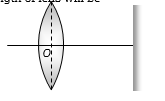A rod of glass ( = 1.5) and of square cross section is bent into the shape shown in the figure. A parallel beam of light falls on the plane flat surface A as shown in the figure. If d is the width of a side and R is the radius of circular arc then for what maximum value of light entering the glass slab through surface A emerges from the glass through B

(1) 1.5
(2) 0.5
(3) 1.3
(4) None of these

A concave mirror is placed at the bottom of an empty tank with face upwards and axis vertical. When sunlight falls normally on the mirror, it is focused at distance of 32 cm from the mirror. If the tank is filled with water upto a height of 20 cm, then the sunlight will now get focussed at
(1) 16 cm above water level
(2) 9 cm above water level
(3) 24 cm below water level
(4) 9 cm below water level
The distance between a convex lens and a plane mirror is 10 cm. The parallel rays incident on the convex lens after reflection from the mirror form image at the optical centre of the lens. Focal length of the lens will be
(1) 10 cm
(2) 20 cm
(3) 30 cm
(4) Cannot be determined
| 1. | \(32.75\) | 2. | \(327.5\) |
| 3. | \(0.3275\) | 4. | None of the above |
An observer can see through a pinhole the top end of a thin rod of height h, placed as shown in the figure. The beaker height is 3h and its radius h. When the beaker is filled with a liquid up to a height 2h, he can see the lower end of the rod. Then the refractive index of the liquid is
(1)
(2)
(3)
(4) 3/2
In an experiment of find the focal length of a concave mirror a graph is drawn between the magnitudes of u and v. The graph looks like

As the position of an object (u) reflected from a concave mirror is varied, the position of the image (v) also varies. By letting the u change from 0 to infinity, the graph between v versus u will be-
The graph between u and v for a convex mirror is
A convex lens A of focal length 20 cm and a concave lens B of focal length 5 cm are kept along the same axis with the distance d between them. If a parallel beam of light falling on A leaves B as a parallel beam, then distance d in cm will be
(1) 25
(2) 15
(3) 30
(4) 50
A medium shows relation between \(i\) and \(r\) as shown. If the speed of light in the medium is \(nc\) then the value of \(n\) is:

| 1. | \(1.5\) | 2. | \(2\) |
| 3. | \(2^{-1}\) | 4. | \(3^{-\frac{1}{2}}\) |










